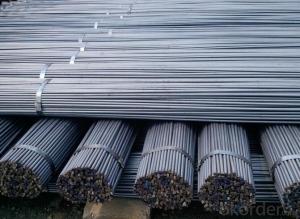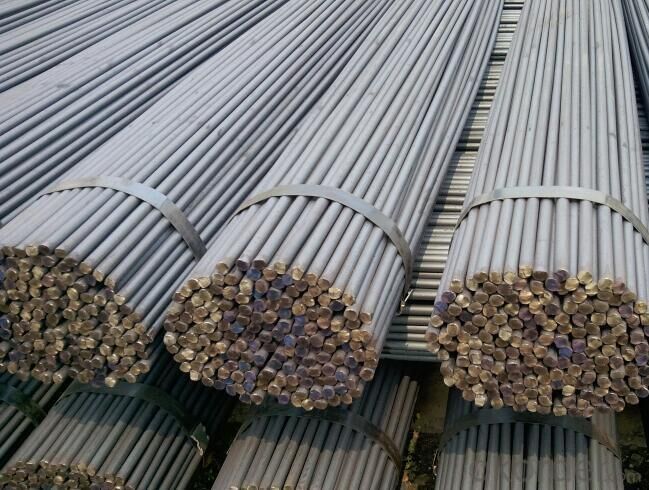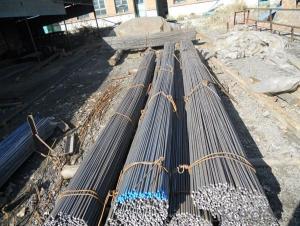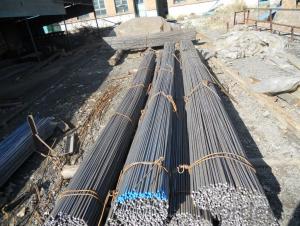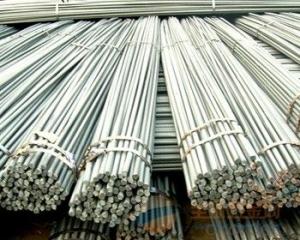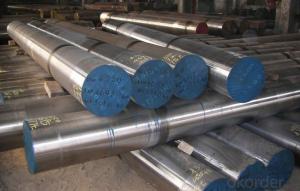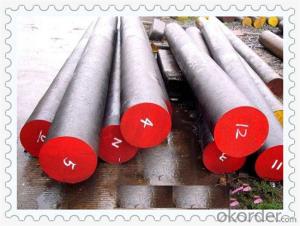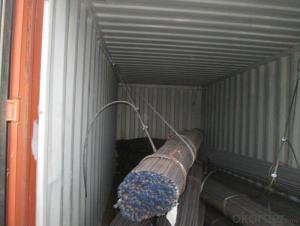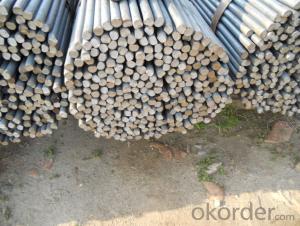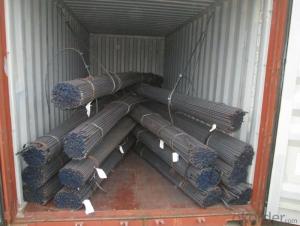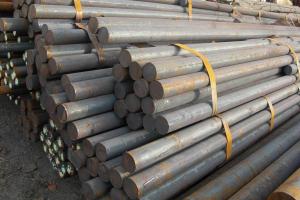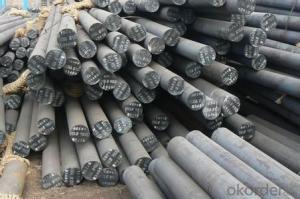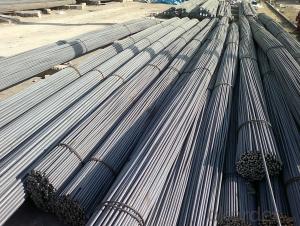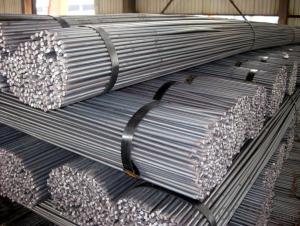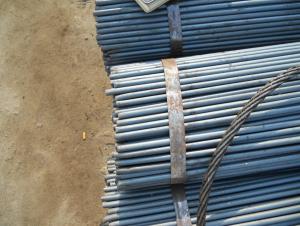Steel Round Bar Product Heat treatment of high quality steel
- Loading Port:
- Tianjin
- Payment Terms:
- TT or LC
- Min Order Qty:
- 25 m.t.
- Supply Capability:
- 7000 m.t./month
OKorder Service Pledge
OKorder Financial Service
You Might Also Like
Specification
OKorder is offering Steel Round Bar Product Heat treatment of high quality steel with worldwide shipping. Our supplier is a world-class manufacturer of steel, with our products utilized the world over. OKorder annually supplies products to European, North American and Asian markets. We provide quotations within 24 hours of receiving an inquiry and guarantee competitive prices.
Product Applications:
Steel Round Bar Product Heat treatment of high quality steel are ideal for structural applications and are widely used in the construction of buildings and bridges, and the manufacturing, petrochemical, and transportation industries.
Product Advantages:
OKorder's Steel Round Bar Product Heat treatment of high quality steel are durable, strong, and resist corrosion.
Main Product Features:
· Premium quality
· Prompt delivery & seaworthy packing (30 days after receiving deposit)
· Corrosion resistance
· Can be recycled and reused
· Mill test certification
· Professional Service
· Competitive pricing
Product Description:
Specifications of Common Steel Round Bar
1. Grade: 304, 316L, 321
2. Type: Mild carbon steel
3. Shape: Round bar, solid bar of steel with circular section
4. Diameter: 8mm-150mm
5. HS Code: 72283010
Usage and Applications of Common Steel Round Bar
1. Common Steel Round Bar of 8-25mm, or small round is mostly used for straight bundles supply, and used for steel, bolts and various mechanical parts. While the bigger round bar, or more than 25mm hot rolled bar, is mainly for the manufacture of mechanical parts or for seamless steel billet.
2. Steel round bar is used in construction and a large number of architectural and engineering structures.
3. Besides, we can supply some especial material steel round bar that can be used for main shaft of steamer, hummer shank, with big section and supper force.
Packaging & Delivery of Common Steel Round Bar
Packaging Detail: All goods are packed in bundle with steel strips and shipped by break bulk vessel or container (depend on target market and different ports)
Delivery Detail: 45 days
Trade terms: FOB, CFR, CIF
MOQ: 25 tons per specification; we can negotiate the quantity if the specification is normal or we have stock of one specification.
Weight: The price invoicing on theoretical weight basis or actual weight basis depends on customer’s request.
Shipment: The shipment of bulk break or container is depends on customer’s request and the situation of the port of destination.
Documents given: Full set of original clean on board bill of lading; Original signed commercial invoice; Original packing list; Policy of insurance; Certificate of origin and what the target market needs.
Production Flow of Common Steel Round Bar
We use advanced equipments like Electric Arc Furnace, Ladle Furnace and Vacuum Degasser to produce our products.
Material prepare (billet) — heat up — rough rolling — precision rolling — cooling — packing — storage and transportation
Characteristics of Common Steel Round Bar
1. The steel in which the main interstitial alloying constituent is carbon in the range of 0.12–2.0%.
2. As the carbon percentage content rises, steel has the ability to become harder and stronger through heat treating; however it becomes less ductile.
3. Quality should be in conformity with the specification of the manufacturer. Quantity and packing conditions should be in conformity with the term in the contract.
4. Regardless of the heat treatment, higher carbon content reduces weld ability. In carbon steels, the higher carbon content lowers the melting point.
FAQ:
Q1: Why buy Materials & Equipment from OKorder.com?
A1: All products offered byOKorder.com are carefully selected from China's most reliable manufacturing enterprises. Through its ISO certifications, OKorder.com adheres to the highest standards and a commitment to supply chain safety and customer satisfaction.
Q2: How do we guarantee the quality of our products?
A2: We have established an advanced quality management system which conducts strict quality tests at every step, from raw materials to the final product. At the same time, we provide extensive follow-up service assurances as required.
Q3: How soon can we receive the product after purchase?
A3: Within three days of placing an order, we will begin production. The specific shipping date is dependent upon international and government factors, but is typically 7 to 10 workdays.
Images:
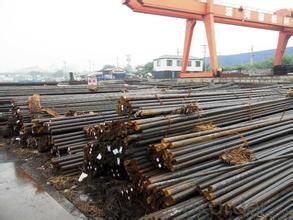

- Q: What are the different types of heat treatments used for steel round bars?
- The different types of heat treatments used for steel round bars include annealing, normalizing, quenching and tempering, and case hardening.
- Q: What are the advantages of using wear-resistant steel round bars?
- Wear-resistant steel round bars offer numerous benefits: 1. Enhanced durability: These round bars are specifically designed to withstand high levels of abrasion and wear. They have a high hardness level, which makes them resistant to surface damage caused by friction, impact, or scraping. As a result, their lifespan is extended, reducing the need for frequent replacements. 2. Increased strength: Wear-resistant steel round bars possess exceptional strength properties, allowing them to withstand heavy loads and extreme conditions. This makes them suitable for various applications in industries like mining, construction, manufacturing, and transportation, where strength and resilience are crucial. 3. Improved safety: By using wear-resistant steel round bars, a safer working environment is ensured. Their high resistance to wear minimizes the risk of accidents and injuries caused by equipment failures or structural damage. This is particularly important in industries involving heavy machinery, tools, or structures. 4. Cost-effectiveness: Although wear-resistant steel round bars may have a higher initial cost compared to regular steel bars, their extended lifespan and reduced maintenance requirements make them a cost-effective choice in the long run. The reduced need for replacements and repairs leads to lower downtime, increased productivity, and ultimately, decreased operational costs. 5. Versatility: Wear-resistant steel round bars can be used in a variety of applications due to their versatility. They can be easily machined, welded, or formed into different shapes and sizes to meet specific requirements. This flexibility allows for their use in various industries and applications, making them an ideal choice for many projects. To sum up, the advantages of using wear-resistant steel round bars include enhanced durability, increased strength, improved safety, cost-effectiveness, and versatility. These properties make them a reliable and efficient option for applications where wear and tear are significant concerns.
- Q: What are the considerations for selecting the right steel grade for a round bar?
- When selecting the right steel grade for a round bar, there are several considerations to be taken into account. Firstly, it is important to consider the intended application of the round bar. Different steel grades have varying properties that make them suitable for specific purposes. For example, if the round bar will be used in a high-temperature environment, a steel grade with excellent heat resistance such as stainless steel or high-alloy steel would be ideal. On the other hand, if the round bar will be used in structural applications, a steel grade with good strength and ductility, such as carbon steel, may be more appropriate. Another consideration is the desired mechanical properties of the round bar. This includes factors such as the required tensile strength, yield strength, hardness, and toughness. These properties can vary significantly between different steel grades, so it is important to choose a grade that meets the specific requirements of the application. The corrosion resistance of the steel grade is also an important consideration. If the round bar will be exposed to corrosive environments, such as in marine or chemical applications, a stainless steel grade with high resistance to corrosion would be recommended. Alternatively, if corrosion resistance is not a major concern, a carbon steel grade may be more cost-effective. Cost is another factor that should be taken into consideration when selecting a steel grade for a round bar. Different steel grades have varying costs based on factors such as availability, demand, and manufacturing processes. It is important to balance the desired properties of the round bar with the available budget to ensure cost-effectiveness. Furthermore, it is important to consider the manufacturability of the steel grade. Some steel grades may be more difficult to machine or weld, which can impact the production process and cost. It is important to choose a steel grade that is readily available and can be easily processed to meet the required specifications. Lastly, it is always advisable to consult with steel suppliers, engineers, or metallurgists to ensure that the chosen steel grade aligns with the specific requirements of the application. They can provide valuable insights and recommendations based on their expertise and experience in the industry.
- Q: What are the different grades of stainless steel round bars?
- There are several grades of stainless steel round bars, with the most common ones being 304, 316, and 410. These grades differ in their chemical composition, strength, and corrosion resistance properties, making them suitable for various applications in different industries.
- Q: What is the toughness of a steel round bar?
- The ability of a steel round bar to resist fracture or deformation under stress is referred to as its toughness. It gauges the steel's capacity to absorb energy and endure impact without breaking. Several factors, including the steel's composition, microstructure, and any heat treatment it has undergone, determine the toughness of a steel round bar. Typically, high-strength and alloy steels have higher toughness due to their improved mechanical properties. Moreover, impurities, grain size, and the presence of defects or cracks within the material can also influence its toughness. To evaluate the toughness of a steel round bar, tests like the Charpy impact test or the Izod test are commonly conducted to measure the energy absorbed by the material before fracture occurs. Ultimately, when choosing a material for applications that require high impact resistance, such as in the construction, automotive, or aerospace industries, considering the toughness of a steel round bar is crucial.
- Q: What is the maximum manganese content allowed for steel round bars?
- The maximum manganese content allowed for steel round bars can vary depending on the specific grade or standard being followed. In general, the manganese content in steel round bars is typically limited to a maximum of around 1.65% by weight. This is because higher levels of manganese can negatively impact the mechanical properties and weldability of the steel. However, it is important to note that different industries or applications may have their own specific requirements or allowances for manganese content in steel round bars. Therefore, it is always advisable to consult the relevant specifications or standards to determine the maximum manganese content allowed for a particular grade of steel round bars.
- Q: How do steel round bars compare to carbon fiber round bars?
- Steel round bars and carbon fiber round bars have different characteristics and applications. Steel round bars are known for their high strength and durability, making them suitable for heavy-duty applications. They can withstand higher loads and provide excellent resistance against wear and tear. On the other hand, carbon fiber round bars are significantly lighter than steel bars while still maintaining high strength. They are commonly used in applications where weight reduction is crucial, such as aerospace and sports equipment. Carbon fiber round bars also offer better corrosion resistance compared to steel. The choice between steel and carbon fiber round bars depends on the specific requirements of the application, considering factors such as strength, weight, and cost.
- Q: What are the different types of steel alloys used for round bars?
- Round bars can be made from various steel alloys, each possessing unique characteristics that make them suitable for different purposes. Some commonly used steel alloys for round bars are as follows: 1. Carbon Steel: The most prevalent type of steel alloy for round bars, carbon steel is primarily composed of carbon and iron. It offers exceptional strength and toughness, making it ideal for applications in construction, manufacturing, and general engineering. 2. Stainless Steel: This alloy incorporates chromium, which grants it excellent resistance to corrosion. Consequently, stainless steel round bars are extensively utilized in the food and beverage industry, as well as in marine and chemical sectors where rust or oxidation is a concern. 3. Alloy Steel: This steel alloy is produced by adding elements like manganese, nickel, or chromium to enhance its mechanical properties. Alloy steel round bars are renowned for their high strength, hardness, and resistance to wear and tear. As a result, they find widespread use in automotive, aerospace, and machinery industries. 4. Tool Steel: Tool steel alloys are specifically engineered to possess remarkable hardness, wear resistance, and toughness. They are employed in the production of cutting tools, dies, and molds. Tool steel round bars are available in different grades, such as D2, O1, and A2, each offering specific properties for distinct applications. 5. Duplex Steel: This alloy combines austenitic and ferritic stainless steels, resulting in a blend of high strength and corrosion resistance. Duplex steel round bars are preferred in applications where both strength and resistance to corrosion are essential, such as in the oil and gas industry. These examples demonstrate the diversity of steel alloys used for round bars. The choice of a specific alloy depends on the desired properties and the intended application of the round bar.
- Q: What is the resistance to wear of a steel round bar?
- The wear resistance of a steel round bar can vary depending on several factors, including the type of steel used, hardness, surface finish, and any coatings or treatments applied. Steel is widely recognized for its exceptional wear resistance and ability to withstand abrasion and friction. Steel possesses inherent durability and strength, making it resistant to wear from repeated or prolonged contact with other surfaces. Its hardness and strength allow it to resist deformation, chipping, or cracking, even in high-stress situations. This quality makes steel round bars suitable for applications involving heavy loads, constant movement, or abrasive environments. However, it is important to acknowledge that external factors can still influence the wear resistance of a steel round bar. For instance, exposure to corrosive environments or improper handling and maintenance can compromise its wear resistance. In such cases, corrosion or surface damage may occur, resulting in a decrease in overall wear resistance. To enhance the wear resistance of a steel round bar, additional measures can be taken. Heat treatments like quenching and tempering can be employed to improve the hardness and strength of the steel, thereby increasing wear resistance. Furthermore, coatings such as chrome plating or nitriding can be utilized to provide an extra layer of protection against wear, reducing friction and extending the lifespan of the steel round bar. In conclusion, steel round bars generally exhibit high wear resistance due to their inherent durability and strength. However, factors such as steel type, surface finish, coatings, and environmental conditions can impact wear resistance. Proper selection, handling, and maintenance of the steel round bar are crucial to ensuring optimal wear resistance and prolonging its lifespan.
- Q: Are steel round bars recyclable?
- Yes, steel round bars are recyclable. Steel is one of the most commonly recycled materials in the world due to its high value and ease of recycling. When steel round bars reach the end of their useful life, they can be collected and sent to a recycling facility. At the recycling facility, the round bars are melted down and transformed into new steel products. This process can be repeated indefinitely without compromising the quality of the steel. Recycling steel round bars not only helps conserve natural resources and reduce waste but also saves energy and reduces greenhouse gas emissions compared to producing steel from raw materials.
Send your message to us
Steel Round Bar Product Heat treatment of high quality steel
- Loading Port:
- Tianjin
- Payment Terms:
- TT or LC
- Min Order Qty:
- 25 m.t.
- Supply Capability:
- 7000 m.t./month
OKorder Service Pledge
OKorder Financial Service
Similar products
Hot products
Hot Searches
Related keywords
